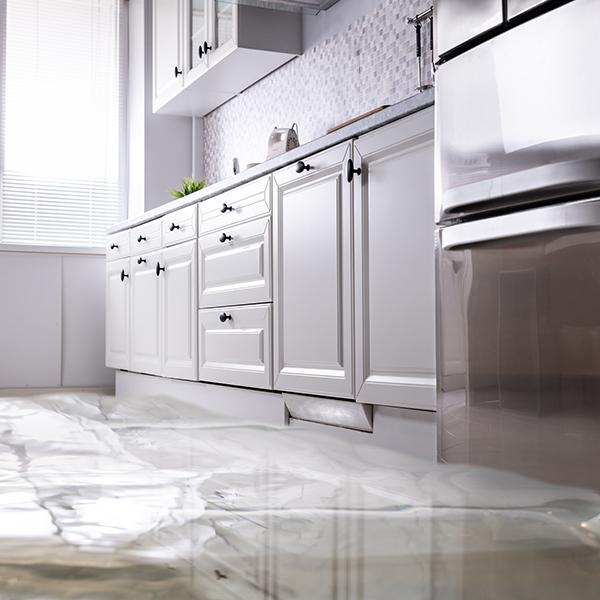
6 Areas in Your Home With the Potential for Leaks
While we may think of flooding as the catastrophic torrent of water that can threaten our home after a natural disaster such as a heavy rainstorm or overflowing river, the much more common cause of house flooding and water damage actually comes from inside the house. Six common areas within the home to be exact. Keeping your eye on these areas to notice any signs of trouble as they appear can help you head off problems before they really wreak havoc on your house and possessions.
- Kitchen Appliances
While there may be an extra bedroom in your house that never gets used, a side den piled high with junk, or a guest bath that only sees a human once every blue moon, the kitchen most definitely does not fall into this unused room category. Visited by often multiple people several times a day, the kitchen is the most used room in a house. As such, the appliances in a kitchen receive wear-and-tear faster than in other places in the home, meaning there is a higher likelihood for leaks or appliance-part failure. Dishwashers have the potential to back up and overflow if debris is not regularly cleaned out and loose connections in the hose can mean water leaking out from beneath the dishwasher. Refrigerators with icemakers and water dispenses are convenient but also come with the added risk of leaks from the hose running from the supply line to the back of the refrigerator.
- Sinks and Bathtubs
Whether it’s in the kitchen, mudroom, or bathroom, all sinks have pieces that can wear down over time and may need to be replaced to avoid leaks. Faucets can begin to drip from the base of the spouts or even the handles, drains can become clogged or loosened, and sink bowls can develop cracks over a period of time. The same goes for bathtub faucets and handles.
- Toilets and Showers
There is a lot of water that moves through the plumbing fixtures in your bathroom. Toilets on average use 1.5 gallons of water with every flush and the average 8-minute long shower uses up 20 gallons. With so much water on the move through the bathroom plumbing, it’s important to keep an eye out for potential leaks. Toilets may have loose connections, whether the plastic nuts under the bowl that aren’t screwed on tightly enough or the hoses that run from the supply line to the back of the tank. If you have a leak in your shower, it’s most likely coming from the showerhead. Investing in a higher quality showerhead can help prevent this…and the annoying drip that inevitably accompanies a bathroom leak.
- Washing Machine
Rivaling the water used during an average shower, washing machines can use anywhere from 15 to 45 gallons a cycle, depending on the year and model of the machine. And although washing machine leaks are less common than, say, a leak beneath the kitchen sink, because they use so much water, it’s worthwhile to keep an eye on them so the water stays where it belongs in the machine and not on your floor. Leaks can potentially happen around the connections on either end of the fill hoses or drain hoses and even at the water inlet system or detergent dispenser for front load washers.
- Water Heater
Most water heaters last anywhere from 8 to 12 years. If you have a water heater that is 10 years or older, it’s time to consider a replacement, as strongly suggested by most industry professionals. The reasoning is that after the 10-year mark a water heater leak is inevitable and it’s really just a matter of time. And while you want to get the most use possible out of what you have, making a replacement is a lot less stressful when you are not being forced to due to a broken, flooded water heater. Rusty water coming from the heater, rumbling noises, a loose drain valve, and high pressure on the gauge are all signs that a leak is most likely not far behind.
- Roof
Just as important as making sure the indoor plumbing and appliances are in good working order is making sure you pay attention to your house’s first line of defense from the elements—the roof. A house’s roofing system protects against rain, snow, winds, debris…and over time a roof will inevitably experience wear and tear. Having the roof checked at least every three years is a good guideline to make sure there isn’t surprise water or moisture entering your home and getting into the attic or drywall. When a roof has sustained damage or is nearing the end of its life, common areas for leaks includes through the roofing material, where the roofing material meets at areas around chimneys or pipes, and in the roof ventilation system.
Being aware of any drips coming from the above-mentioned areas and regularly checking for loose hoses connected to appliances can help you address leaks before they even happen. And while some leaks, such as from a loose connection or an old faucet that needs to be replaced, are simple enough to tackle for many homeowners, don’t hesitate to call a professional if you’re not sure what to do. They have the expertise to be able to see exactly what is wrong when there is a leak and know how to fix it.
Give us a call!
If you have water damage, hiring a professional water extraction team like Water Extraction Experts can give you peace of mind that your home is in good hands.
We are equipped to guide you through the process of protecting your property and getting you back to your life as soon as possible.
We work directly with your insurance.
EMERGENCY 24/7 WATER, FIRE, STORM, DAMAGE SERVICES
